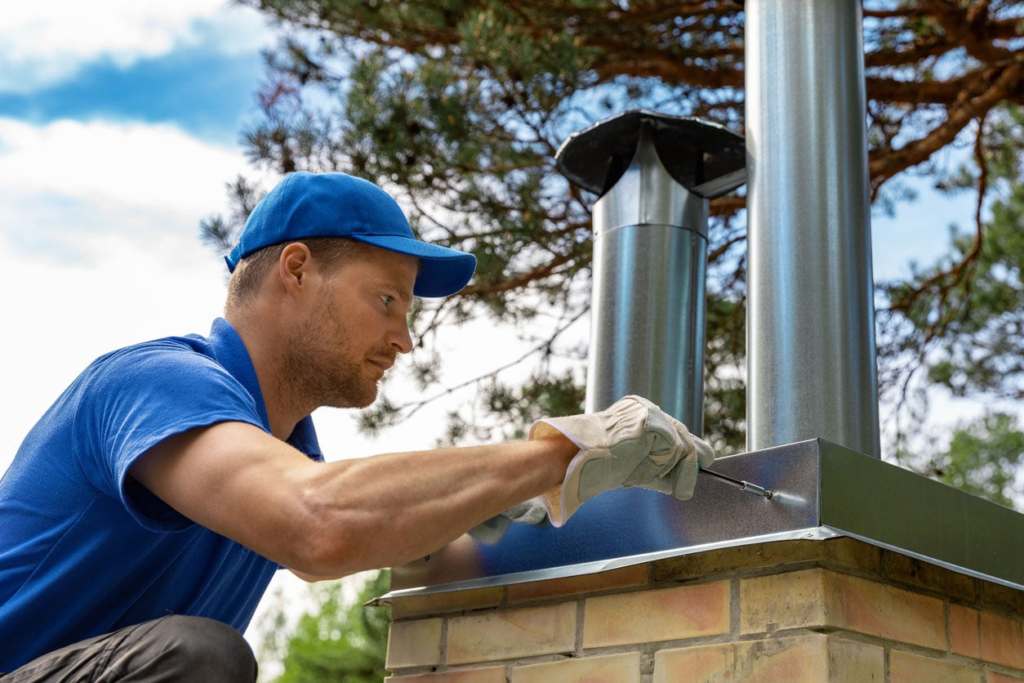The phrase ‘a chimney that’s on fire’is often used to describe a situation that’s gotten out of control. While this might seem like an exaggeration, it’s important to remember that a poorly maintained chimney can lead to serious and even life-threatening situations.
Chimneys play a vital role in our homes by safely venting smoke and gases from our fireplaces, but if not properly cared for, they can become clogged with soot and debris or develop dangerous creosote buildup. That’s why maintaining a safe and efficient chimney should be at the top of any homeowner’s priority list.
Regular inspections and cleanings are essential when it comes to maintaining your chimney. Even if you only use your fireplace occasionally, small amounts of debris can accumulate over time, leading to blockages that could cause smoke and toxic gases to enter your home instead of being expelled outside. A professional inspection will identify any potential hazards such as damaged flue tiles or cracked masonry, while regular cleanings will remove any build-up of soot or creosote which could ignite causing an unwelcome house fire.
In the next section we’ll explore some best practices for using your fireplace in order to keep both you and your family safe all winter long.
Importance of Chimney Maintenance
The importance of regular chimney maintenance cannot be overstated, as it ensures safe and efficient functioning while preventing potential hazards such as fire and carbon monoxide poisoning.
A well-maintained chimney can reduce the risk of structural damage caused by creosote buildup, which is a highly flammable substance that accumulates over time in the chimney’s flue.
Furthermore, when the chimney is not regularly inspected and cleaned, it can result in poor air quality due to harmful fumes from gases like carbon monoxide being released into your home.
It is crucial to schedule an annual inspection with a certified professional to ensure that your chimney meets safety standards.
During an inspection, issues such as cracks or gaps in the lining or bricks can be identified early on before they escalate into more severe problems.
Regular cleaning also helps eliminate any debris or blockages that may prevent proper airflow through your chimney.
Neglecting regular maintenance puts you at risk for costly repairs down the line and could even endanger your family’s health and safety.
Regular Inspections and Cleanings
Regular inspections and cleanings of the flue are imperative for preventing dangerous build-up of creosote, a highly flammable substance that can ignite and cause a devastating chimney fire. During an inspection, professionals will check for any obstructions or damages in the chimney that may prevent proper ventilation. They will also assess the condition of the chimney liner to ensure it is still intact and functioning correctly.
To maintain a safe and efficient chimney, homeowners should follow these four steps:
1. Schedule annual inspections with a certified chimney sweep who can identify potential hazards before they become major problems.
2. Have your chimney cleaned at least once a year to remove any creosote build-up.
3. Install carbon monoxide detectors near your fireplace or wood stove to alert you if there are any issues with ventilation.
4. Only burn seasoned hardwoods in your fireplace or wood stove as softwoods contain more sap which leads to increased creosote buildup.
By following these guidelines, homeowners can ensure their chimneys remain safe and functional while reducing the risk of costly repairs or even worse – potential fires. It’s crucial to prioritize regular maintenance as part of owning a home with a fireplace or wood stove, so don’t hesitate to schedule an inspection today!
Proper Fireplace Use and Maintenance
To ensure the optimal functionality and longevity of a fireplace, it is important to practice proper use and maintenance procedures.
First and foremost, it’s essential to only burn appropriate materials in your fireplace. Burning wet or green wood can create excess creosote buildup in your chimney, which can lead to dangerous conditions such as chimney fires. Additionally, avoid burning paper products or other items that could easily ignite and pose a fire hazard.
Another crucial aspect of proper fireplace use is ensuring adequate ventilation. Always keep the damper open while using your fireplace to allow smoke and gases to escape properly. Failure to do so can cause carbon monoxide buildup within your home, which can be deadly. It’s also recommended to have a carbon monoxide detector installed near your fireplace for added safety measures.
In terms of maintenance, regularly removing ashes from the hearth area is important for both safety and efficiency reasons. Excess ash buildup can restrict airflow into the firebox, making it harder for flames to ignite and decreasing overall heating efficiency.
Finally, scheduling annual inspections with a certified chimney sweep will ensure that any potential issues are caught early on before they become major problems that compromise the safety of your home. By following these guidelines for proper use and maintenance of your fireplace, you’ll enjoy warmth and comfort all winter long while keeping your family safe from harm.
READ MORE:

